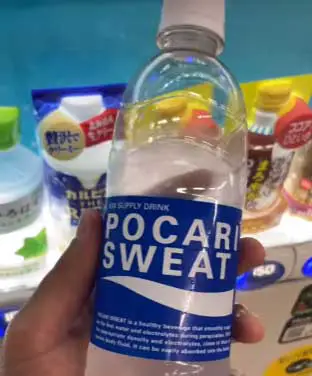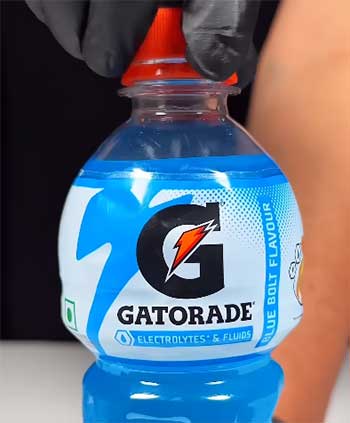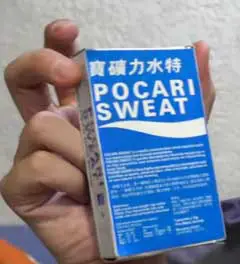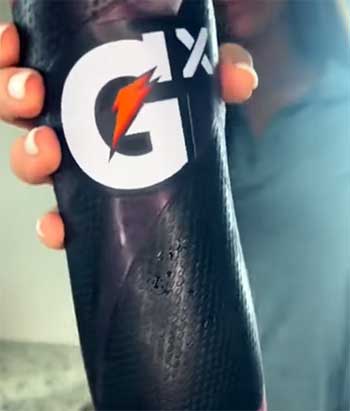I’m no stranger to the world of sports drinks, having spent years sweating it out on trails, tracks, and gym floors. When it comes to staying hydrated, two names often dominate the conversation: Pocari Sweat and Gatorade.
In this article, I’ll share my experience comparing these popular hydration drinks, exploring their ingredients, benefits, and drawbacks to help you decide which one suits your needs.
With a focus on real-world use, I’ll break down their pros and cons, analyze key features, and answer common questions to guide your choice in the quest for optimal hydration.
A Brief Comparison Table
| Feature | Pocari Sweat | Gatorade Thirst Quencher |
| Primary Purpose | General hydration, electrolyte balance | Athletic performance, rapid rehydration |
| Calories (12 oz) | ~80 kcal | ~80 kcal |
| Sugar (12 oz) | ~19g | ~21g |
| Sodium (12 oz) | ~180mg | ~160mg |
| Potassium (12 oz) | ~60mg | ~50mg |
| Other Nutrients | Magnesium, calcium | None notable |
| Artificial Additives | No artificial colors/flavors | Artificial colors, flavors in some |
| Target Audience | General consumers, light activity | Athletes, intense exercise |
| Availability | Strong in Asia, limited globally | Widely available globally |
| Price (12 oz) | ~$1.50–$2.00 (varies by region) | ~$1.00–$1.50 (varies by region) |
| Taste Profile | Mild, slightly sweet | Bold, sweet, tangy |
My Hydration Journey
Growing up, I was that kid who’d chug Gatorade after every soccer practice, convinced it was the key to my nonexistent athletic stardom. The bright colors and bold flavors felt like a reward for surviving wind sprints.
Years later, while traveling in Asia, I discovered Pocari Sweat, a drink that promised hydration without the neon glow. It was a game-changer, but it got me thinking: which of these drinks is actually better?
To find out, I’ve put both through the wringer, testing them during workouts, travel, and even the occasional hangover.
Understanding Sports Drinks
Sports drinks like Pocari Sweat and Gatorade are designed to replenish what your body loses during physical activity: water, electrolytes, and sometimes carbohydrates.
They’re not just fancy water—they’re formulated to restore sodium, potassium, and other minerals lost through sweat.
But not all sports drinks are created equal, and their differences can make or break your hydration strategy. Let’s break down what each brings to the table.
Pocari Sweat: The Understated Hydrator
Pocari Sweat, a Japanese invention from Otsuka Corporation, has been a staple in Asia since 1980.
I first tried it during a humid summer in Tokyo, where it felt like a lifeline. Its name might sound odd—sweat isn’t exactly appetizing—but it reflects its purpose: replacing what you lose when you perspire.
- Key Features of Pocari Sweat

Pocari Sweat’s formula is inspired by oral rehydration solutions (ORS), which are used medically to treat dehydration.
A 12-ounce serving contains about 80 calories, 19 grams of sugar, 180 milligrams of sodium, 60 milligrams of potassium, and small amounts of magnesium and calcium.
What stands out is its lack of artificial colors or flavors, giving it a clean, mild taste that’s slightly sweet but not overpowering.
I’ve found Pocari Sweat to be my go-to for everyday hydration, especially during travel or mild exercise like hiking.
Its electrolyte balance mimics the body’s natural fluids, making it effective for general use. It’s also marketed as a health-conscious option, often recommended by doctors in Asia for its ORS-like properties.
Pros of Pocari Sweat
- Clean Ingredients: No artificial colors or flavors, which is a big plus for me. I don’t love the idea of drinking something that looks like it belongs in a chemistry lab.
- Balanced Electrolytes: The inclusion of magnesium and calcium, alongside sodium and potassium, supports broader mineral replenishment.
- Mild Taste: Its subtle flavor doesn’t overwhelm, making it easy to drink regularly without palate fatigue.
- Medical Credibility: Often recommended by healthcare professionals in Asia for dehydration, especially for kids or those recovering from illness.
- Versatile Use: Works well for non-athletic scenarios, like hot weather or post-illness recovery.
Cons of Pocari Sweat
- Limited Availability: Outside Asia, finding Pocari Sweat can be a hassle. I’ve had to hunt it down in specialty stores or order online, which isn’t always convenient.
- Higher Price Point: It’s often pricier than Gatorade, sometimes costing $1.50–$2.00 for a 12-ounce bottle.
- Lower Potassium: Compared to some competitors, its potassium content is modest, which might matter for intense workouts.
- Less Bold Flavor: If you’re used to punchy tastes, Pocari’s subtlety might feel underwhelming.
Gatorade: The Athletic Powerhouse
Gatorade, created in 1965 at the University of Florida, is practically synonymous with sports drinks. I remember gulping down Fruit Punch after high school track meets, feeling like I was fueling up like a pro. It’s designed for athletes, with a focus on rapid rehydration and energy replenishment during intense exercise.
Key Features of Gatorade

A 12-ounce serving of Gatorade Thirst Quencher delivers about 80 calories, 21 grams of sugar, 160 milligrams of sodium, and 50 milligrams of potassium.
It’s packed with carbohydrates for quick energy, and its bold flavors—like Cool Blue or Lemon-Lime—are instantly recognizable.
However, some versions contain artificial colors and flavors, which can be a turn-off for health-conscious folks.
Gatorade shines during high-intensity activities. I’ve used it for long runs and gym sessions, where its quick-absorbing carbs give me a noticeable energy boost.
It’s also widely available, from gas stations to supermarkets, making it a convenient choice.
Pros of Gatorade
- Global Availability: You can find Gatorade almost anywhere, from corner stores to vending machines.
- Energy Boost: The higher sugar content provides quick carbs, ideal for endurance sports or prolonged workouts.
- Variety of Flavors: With dozens of flavors, there’s something for everyone. I’m partial to Glacier Freeze for its crisp taste.
- Affordable: Typically cheaper than Pocari Sweat, often retailing for $1.00–$1.50 per 12-ounce bottle.
- Athlete-Focused: Designed with sports in mind, it’s tailored for those pushing their physical limits.
Cons of Gatorade
- Artificial Additives: Some flavors include artificial colors and flavors, which I try to avoid when possible.
- Higher Sugar: At 21 grams per 12 ounces, it’s slightly sweeter than Pocari Sweat, which might not suit everyone.
- Less Versatile: It’s overkill for casual hydration or non-exercise scenarios, like recovering from a cold.
- Sodium Concerns: While sodium is crucial, heavy sweaters might need more than Gatorade provides.
Ingredients Breakdown of Pocari Sweat And Gatorade
Let’s get into the nitty-gritty of what’s inside these drinks. Both Pocari Sweat and Gatorade rely on water, sugar, and electrolytes, but their approaches differ slightly.
- Pocari Sweat Ingredients

Pocari Sweat’s ingredient list is straightforward: water, sugar, citric acid, sodium citrate, sodium chloride, potassium chloride, calcium lactate, magnesium carbonate, and flavoring.
The inclusion of calcium and magnesium gives it an edge for overall mineral balance.
I appreciate that it avoids artificial dyes, which makes it feel like a cleaner choice.
The sugar content, at 19 grams per 12 ounces, is moderate, providing energy without overwhelming sweetness.
- Gatorade Ingredients
Gatorade’s Thirst Quencher includes water, sugar, dextrose, citric acid, sodium chloride, sodium citrate, monopotassium phosphate, and artificial flavors/colors (in some varieties). The 21 grams of sugar per 12 ounces is slightly higher than Pocari Sweat, which I notice in its sweeter taste.
The artificial additives, like Yellow 5 or Red 40 in certain flavors, are a downside for me, especially since I’ve become more mindful of what I consume.
Nutritional Comparison
Both drinks have similar calorie counts (~80 kcal per 12 ounces), but Pocari Sweat edges out with slightly less sugar and more diverse electrolytes. Gatorade’s higher sugar content makes it better for quick energy, but Pocari’s magnesium and calcium add value for general health.
Sodium levels are comparable, though Pocari Sweat has a slight edge (180mg vs. 160mg), which matters for rehydration. Potassium is close, with Pocari at 60mg and Gatorade at 50mg.
Performance in Real-World Scenarios
To really understand these drinks, I tested them in different situations: a 10K run, a day of travel, and a post-flu recovery. Here’s how they stacked up.
- During Exercise
For my 10K run, Gatorade was the winner. Its higher sugar content gave me a quick energy boost around mile 4, when I started feeling sluggish. The bold Lemon-Lime flavor was motivating, almost like a treat mid-run.
Pocari Sweat, while hydrating, didn’t provide the same immediate kick, likely due to its lower carb content. However, it felt lighter on my stomach, which was nice for avoiding that heavy, sloshy feeling.
- Travel and Everyday Use
On a long flight to Southeast Asia, Pocari Sweat was my go-to. The mild taste and balanced electrolytes kept me hydrated without the sugar crash I sometimes get from sweeter drinks.
Gatorade, while effective, felt too intense for sipping casually—it’s more suited to active moments. Pocari’s clean formula also made me feel better about drinking it regularly during travel.
- Post-Illness Recovery
After a bout of flu, Pocari Sweat shone. Its ORS-inspired formula helped me recover from dehydration caused by fever and lack of appetite. The subtle flavor was easy to stomach when I wasn’t feeling my best.
Gatorade, while hydrating, was less appealing due to its sweetness and artificial additives, which didn’t sit well during recovery.
- Health Considerations

Both drinks have their place, but health impacts depend on your needs.
Gatorade’s higher sugar content can be a concern for non-athletes, potentially contributing to weight gain or blood sugar spikes if consumed excessively.
A 2018 meta-analysis noted that industry-funded studies (like those from Gatorade) often favor sports drinks, but independent research suggests they’re only necessary for intense, prolonged exercise.
For casual use, water is often enough.
Pocari Sweat, with its cleaner ingredients and lower sugar, feels like a safer bet for daily hydration. Its ORS-like formula is particularly effective for dehydration from illness or heat, which is why it’s often recommended by doctors in Asia.
However, both drinks contain sodium, which could be an issue for those on low-sodium diets.
Other Differences Between Pocari Sweat And Gatorade
- Cost and Accessibility
Gatorade’s global dominance makes it easier to find and cheaper, typically costing $1.00–$1.50 per 12-ounce bottle. Pocari Sweat, while widely available in Asia, is harder to come by elsewhere, often retailing for $1.50–$2.00.
I’ve spent more time than I’d like searching for Pocari in the U.S., which can be frustrating. If convenience and budget are priorities, Gatorade wins hands-down.
- Taste and Preference
Taste is subjective, but it’s a big factor. Gatorade’s bold, sweet flavors are a hit for those who love a punchy drink. I enjoy the variety, but sometimes the sweetness is too much, especially after multiple bottles.
Pocari Sweat’s mild, slightly citrusy taste is more neutral, which I prefer for sipping throughout the day. It’s less likely to leave you feeling like you’ve just downed a candy bar.
- Environmental Impact
Both brands use plastic bottles, which is a downside for eco-conscious folks like me. Gatorade offers powder mixes, which reduce packaging waste, but Pocari Sweat is primarily sold in bottles or cans.
Neither brand stands out as particularly sustainable, so I try to recycle diligently and opt for reusable bottles with powder mixes when possible.
Expert Opinions and Recommendations
Doctors often lean toward Pocari Sweat for medical hydration needs, especially in Asia, due to its ORS-like formula. A pediatrician I spoke with in Japan recommended it for kids recovering from illness, citing its balanced electrolytes and lack of artificial additives.
Gatorade, however, is endorsed by sports professionals for its performance benefits, particularly for athletes needing quick carbs and hydration.
Research supports both drinks for specific uses. A study found Gatorade as effective as Pedialyte for treating dehydration in adults with viral infections, suggesting it’s a solid choice for recovery.
Pocari Sweat’s formula aligns with World Health Organization ORS guidelines, making it a go-to for clinical dehydration scenarios.
After testing both drinks, I lean toward Pocari Sweat for its clean ingredients and versatility. It’s my pick for everyday hydration, travel, or recovery from illness. Gatorade, however, is hard to beat for intense workouts or when I need a quick energy boost.
Your choice depends on your lifestyle—athletes might prefer Gatorade’s punch, while health-conscious folks or those in hot climates might gravitate toward Pocari Sweat.
Frequently Asked Questions (FAQ)
Pocari Sweat is healthier than many sugary drinks, with no artificial colors or flavors and a balanced electrolyte profile. It’s a solid choice for hydration but contains sugar, so moderation is key.
It depends on your needs. Gatorade is better for intense exercise due to its higher sugar and bold flavors. Pocari Sweat is ideal for general hydration and recovery, with cleaner ingredients.
Yes, its ORS-inspired formula effectively combats dehydration, especially from illness or heat, by restoring electrolytes and fluids.
Doctors, particularly in Asia, recommend Pocari Sweat for its balanced electrolytes and lack of artificial additives, making it suitable for medical hydration needs like post-illness recovery.
Wrapping Up
You’ve got two solid options in Pocari Sweat and Gatorade, each with its strengths. If you’re hitting the gym or running a marathon, Gatorade’s quick energy and bold taste might be your vibe.
If you’re after a cleaner, more versatile drink for everyday hydration or recovery, Pocari Sweat’s got you covered. I’ve shared my experiences to help you weigh the pros and cons, but it’s your call—think about your lifestyle, taste preferences, and health goals.
Whichever you choose, stay hydrated and keep moving forward.
